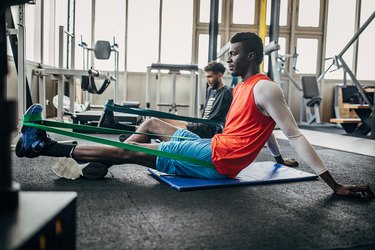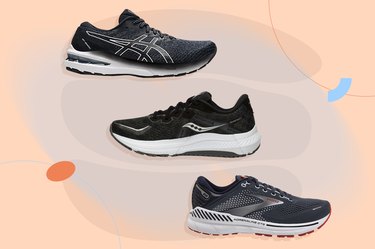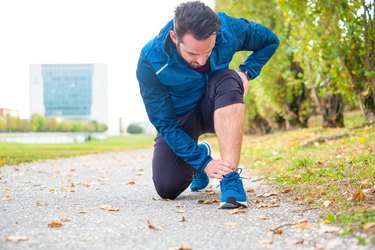
While you may not actively think about this, your ankles support every movement you make: walking, running, jumping, squatting — the list goes on. So, it's important to build ankle muscle just like you would any other muscles in your body.
So, how do you strengthen your ankle muscles? Ahead, we'll talk through the best exercises to do so, along with the benefits of strengthening your ankle area and what muscles are in the ankle.
Video of the Day
A Quick Ankle Anatomy Refresher
Before diving into the best exercises to strengthen your ankles, it's helpful to know exactly which muscles control the movement of your ankle joint.
Because these muscles all have to work together to move your ankles in different ways, having an imbalance can be detrimental. That's why it's so important to strengthen them all around.
The muscles that let you point your foot down and away from your body (called plantarflexion) include the following, per the Cleveland Clinic:
- Gastrocnemius (calf)
- Soleus (calf)
- Plantaris (calf)
- Tibialis posterior (calf)
- Flexor digitorum longus (lower leg)
- Flexor hallucis longus (lower leg)
- Peroneus brevis (side of lower leg)
- Peroneus longus (side of lower leg)
The muscles that let you flex your foot up toward your body (called dorsiflexion) include the following:
- Tibialis anterior (shin)
- Extensor digitorum longus (side of shin)
- Extensor hallucis longus (lower shin)
- Peroneus tertius (outside ankle)
3 Benefits of Strengthening Your Ankles
There are numerous reasons why you may want to gain ankle muscle and build ankle strength, per the American Sports and Fitness Association (ASFA).
1. Decreased Risk of Injury
Strengthening your ankles improves the stability of your ankle joints, which can prevent rolling or twisting your ankles, leading to a sprain.
Other conditions related to ankle instability include stress fractures, shin splints and Achilles tendonitis, which are common in people who participate in high-impact activities, like running.
2. Better Athletic Performance
Strong ankles are essential for giving you a stable base for sports that involve jumping, running and quick direction changes. Even if you don't play any sports and just strength train at the gym, it's harder to perform exercises like squats, deadlifts and lunges with weak ankles.
3. Enhanced Functional Fitness
The term "functional fitness" refers to being able to do real-world activities — like climbing stairs, carrying groceries or picking up your pet or child — with ease. Having strong ankles improves your balance, coordination and stability so you can execute these tasks (and more!) without much effort.
The 7 Best Exercises for Strong Ankles
Complete 1 to 3 sets of 10 repetitions of each of the following moves in this ankle workout routine, recommended by Dynamic Sports Medicine.
1. Ankle Rotation
- Sit on a chair with your feet flat on the floor, knees bent at 90-degree angles and hands resting gently on your knees.
- Lift your right foot off the floor and drive your right knee up toward your chest to cross your right ankle over your left knee.
- Slowly rotate your right ankle in a counter-clockwise direction 10 times.
- Then, slowly rotate your right ankle in a clockwise direction 10 times.
- Repeat on your left ankle.
2. Standing Heel Raise
- Stand on the edge of a stair so that only the balls of your feet are on the stair and your heels are hanging over the edge. (Stand on flat ground if you don't have access to stairs.)
- Hold onto a stair rail for balance, if necessary.
- Rise up on your toes, and then slowly lower your heels so that they come below the stair and you feel a stretch through your calf muscle.
- Hold for a moment before rising up again and repeating.
3. Banded Ankle Inversion
- Start sitting on a mat with your legs straight out in front of you. (You may want to place a rolled up towel underneath your calves for extra support.)
- Secure a resistance around your left foot.
- Hold the resistance band with your left hand and place your right hand on the ground for support.
- Cross your right leg over your left leg so that your right foot presses into the resistance band.
- Move your left ankle down and inward.
- Return it to the resting position.
- Continue to repeat, then switch sides.
4. Banded Ankle Eversion
- Start sitting on a mat with your legs straight out in front of you. (You may want to place a rolled up towel underneath your calves for extra support.)
- Secure a resistance around your left foot and and wrap the middle of the band around your right forefoot.
- Hold the resistance band with your left hand and place your right hand on the ground for support.
- Move your right foot up and out, away from the midline of your body.
- Return it to the resting position.
- Continue to repeat, then switch sides.
5. Banded Dorsiflexion
- Start sitting on a mat with your legs straight out in front of you. (You may want to place a rolled up towel underneath your calves for extra support.)
- Secure a resistance around your left foot and and wrap the middle of the band around your right forefoot.
- Hold the resistance band with your left hand and place your right hand on the ground for support.
- Pull your right ankle up as far as you can, straightening your right foot so that your toes are pointing toward the ceiling.
- Release.
- Continue to repeat, then switch sides.
6. Banded Plantarflexion
- Start sitting on a mat with your right leg straight out in front of you and your left knee bent, left foot flat on the floor. (You may want to place a rolled up towel underneath your right calf for extra support.)
- Anchor a resistance band around your right foot and hold the ends of the band with both hands.
- Push your right ankle down, pointing your toes as far as you can, then return to the starting position.
- Continue to repeat, then switch sides.
7. Squat Jump
- Stand with your feet shoulder-width apart and your toes facing forward or slightly outward.
- Keeping your feet flat on the floor and back straight, brace your core and push your hips back and down until your thighs are parallel to the floor (or as low as you can comfortably go).
- From the bottom of your squat, push through your feet to jump explosively off the ground. (You can extend your arms down along your sides as you do.)
- Land safely with your knees slightly bent.
- Repeat
Does Walking Strengthen Your Ankles?
In a word: yes. Walking helps strengthen the muscles and bones in your feet and ankles and makes your ankle muscles, tendons and ligaments more stable and flexible, according to Crofton Podiatry.
How to Build Ankle Muscle With Your Diet
Although your workouts are a major part of building strength and muscle tone, your diet also plays a big role. Choosing a healthy, sustainable — and enjoyable — eating plan will help you achieve the strong ankles you're looking for.
Focus on adding more fruits and vegetables and lean protein from chicken, fish and beans into your diet, per the current Dietary Guidelines for Americans. Consume moderate amounts of whole grains and dairy and small amounts of healthy fats from nuts, olive oil and avocado.
These foods will keep you fuller for longer, and they'll provide the nutrients you need to stay energized for your workouts.
- American Council on Exercise: "Ankle Flexion"
- USDA: "Dietary Guidelines for Americans, 2020-2025 and Online Materials"
- Cleveland Clinic: "Ankle Joint"
- Dynamic Sports Medicine: "The Importance of Strong Ankles"
- Crofton Podiatry: "The Benefits of Walking"
- ASFA: "Build Strong and Stable Ankles: The Top 10 Benefits of Ankle Eversions"


